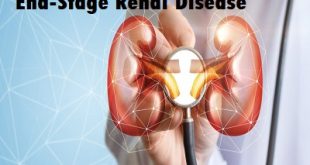What is endometrial hyperplasia?
Endometrial hyperplasia is an excessive or abnormal thickening of the lining of the uterus. This lining, called the endometrium, thickens every month in preparation for pregnancy. If pregnancy does not occur, the lining is shed. This shedding process is called a menstrual period or menstruation. Most women have a normal menstrual period approximately every 28 days. This entire process is controlled by two hormones: estrogen and progesterone. If the hormones are out of balance or not available, then excessive growth of the cells lining the uterus may occur, which results in endometrial hyperplasia.
Most cases of endometrial hyperplasia are benign, or noncancerous. Because of the associated hormonal changes, this condition is most common among women who are nearing menopause or have reached menopause. It may also occur because of chronic disorders, such as diabetes, obesity, or polycystic ovarian syndrome.
What are the types of endometrial hyperplasia?
Doctors classify endometrial hyperplasia based on the kinds of cell changes in the endometrial lining. Types of it include:
- Simple endometrial hyperplasia (without atypia): This type of endometrial hyperplasia has normal-looking cells that aren’t likely to become cancerous. This condition may improve without treatment. Hormone therapy helps in some cases.
- Simple or complex atypical endometrial hyperplasia: An overgrowth of abnormal cells causes this precancerous condition. Without treatment, your risk of endometrial or uterine cancer increases.
Pathophysiology of endometrial hyperplasia
Endometrial hyperplasia is caused by increased amounts of estrogen unopposed by progesterone.
In a normal cycle, estrogen is released from the ovaries, which induces the endometrium to proliferate in preparation for implantation. Ovulation causes progesterone to increase, which stabilizes and prepares the endometrium for possible implantation. If no implantation occurs, then both estrogen and progesterone levels decrease and menstruation occurs.
As a woman ages and reaches perimenopause and menopause, ovulation occurs less often or not at all. Due to the lack of ovulation, there is a loss of progesterone to counteract remaining estrogen. Estrogen then allows for increased and unopposed growth of the endometrium.
With increased proliferation come risks for abnormal changes in nuclei—atypia. Atypia is associated with a chance as high as 60% of having or developing endometrial cancer. However, in many cases, hyperplasia regresses on its own.
If malignancy develops, most cases are type 1 endometrioid adenocarcinomas, which have more favorable outcomes.
What causes endometrial hyperplasia?
Your menstrual cycle relies primarily on the hormones estrogen and progesterone. Estrogen helps grow cells on the lining of the uterus. When no pregnancy takes place, a drop in your progesterone level tells your uterus to shed its lining. That gets your period started and the cycle begins again.
When these two hormones are in balance, everything runs smoothly. But if you have too much or too little, things can get out of sync.
The most common cause of endometrial hyperplasia is having too much estrogen and not enough progesterone. That leads to cell overgrowth.
There are several reasons you might have a hormonal imbalance:
- You’ve reached menopause. This means you no longer ovulate and your body doesn’t produce progesterone.
- You’re in perimenopause. Ovulation doesn’t happen regularly anymore.
- You’re beyond menopause and have taken or are currently taking estrogen (hormone replacement therapy).
- You have an irregular cycle, infertility, or polycystic ovary syndrome.
- You take medications that imitate estrogen.
- You’re considered obese.
Risk Factors
Risk factors for endometrial hyperplasia include:
- Obesity
- Polycystic ovary syndrome (PCOS)
- Estrogen therapy without progesterone
- Estrogen-secreting ovarian tumors
- Age 35 or older
- Caucasian
- Never having been pregnant
- First period at an early age
- Menopause at an older age
- History of conditions such as diabetes mellitus, gallbladder disease, or thyroid disease
- Cigarette smoking
- Family history of ovarian, colon, or uterine cancer
What are the symptoms of endometrial hyperplasia?
Symptoms of endometrial hyperplasia include changes in menstrual periods. Some women also experience symptoms that are outside of the reproductive system, such as hot flashes (also known as hot flushes), which are feelings of intense heat along with excessive sweating and a rapid heart rate.
Common symptoms of endometrial hyperplasia
You may experience its symptoms daily or just once in a while. At times, any of these symptoms can be severe:
- Acne
- Bleeding or spotting between menstrual periods
- Dryness of the vagina
- Excessive growth of body hair
- Heavy bleeding during your menstrual period (menorrhagia)
- Hot flashes or hot flushes
- Missed menstrual periods
- Mood swings
- Pain during sexual intercourse
- Rapid heart rate (tachycardia)
- Severe fatigue
- Tenderness of the vagina
Symptoms that might indicate a serious condition
In some cases, endometrial hyperplasia may occur with other symptoms that might indicate a serious condition and that should be immediately evaluated in an emergency setting. Seek immediate medical care (call 911) if you, or someone you are with, have endometrial hyperplasia along with other serious symptoms including:
- Fainting or change in level of consciousness
- Rapid heart rate (tachycardia)
- Severe abdominal pain
What are the potential complications?
Although endometrial hyperplasia usually is not cancerous, it is a risk factor for the development of cancer of the uterus. Menstruating women with endometrial hyperplasia have a risk of developing anemia (low red blood cell count).
Complications of untreated or poorly controlled endometrial hyperplasia can be serious. You can help minimize your risk of serious complications by following the treatment plan you and your health care professional design specifically for you. Complications of endometrial hyperplasia include:
- Absenteeism from work or school
- Anemia (low red blood cell count)
- Cancer of the uterus
- Inability to participate normally in activities
- Infertility
- Menorrhagia (heavy bleeding during your menstrual period)
How is endometrial hyperplasia diagnosed?
Many conditions can cause abnormal bleeding. To identify what’s causing symptoms, your healthcare provider may order one or more of these tests:
Ultrasound: A transvaginal ultrasound uses sound waves to produce images of the uterus. The images can show if the lining is thick.
Biopsy: An endometrial biopsy removes tissue samples from the uterus lining. Pathologists study the cells to confirm or rule out cancer.
Hysteroscopy: Your provider uses a thin, lighted tool called a hysteroscope to examine the cervix and look inside the uterus. Your provider may perform this procedure along with a dilation and curettage (D&C) or biopsy. It’s most advantageous to couple this with a visually directed dilation and curettage of the endometrium. With hysteroscopy, your provider can see abnormalities within the endometrial cavity and take a targeted (directed) biopsy of any suspicious areas.
Treatment
It is very important that all endometrial hyperplasia be closely followed or treated. The course of treatment will depend on whether or not there is atypia.1
Treatment for endometrial hyperplasia without atypia
When there are no atypical cells present, the chance of endometrial hyperplasia eventually becoming endometrial cancer is very unlikely. The evidence suggests that only about 5% of women with endometrial hyperplasia without atypia will develop endometrial cancer. It is also likely that this type of endometrial hyperplasia will resolve on its own over time.
Target Risk Factors
The first line of treatment is to look for risk factors that are modifiable. For example, if you are significantly overweight or obese, losing weight will help decrease the excess estrogen produced by fat cells. This will allow the lining of your uterus to reset itself.
Similarly, if you are taking hormone replacement therapy your doctor may either need to adjust your dose or recommend that you discontinue using it.
Progesterone
Your doctor may recommend using progestin treatments to counteract the thickening effect of the excess estrogen on your endometrium. Reasons your doctor may suggest treating you with progesterone include:
- Observation and lifestyle changes didn’t work
- You are having abnormal uterine bleeding
- You want the fastest result
The two types of progesterone suggested for the treatment of endometrial hyperplasia without atypia are oral progesterone or a progesterone-containing IUD. The evidence favors using the levonorgestrel IUD (Mirena).
If your BMI is over 35, it is more likely that progesterone treatment will not work well unless you also lose weight. You should discuss with your doctor which type of progesterone treatment is best for you.
Pharmaceutical Therapies
Beyond using progesterone therapy, your doctor may also recommend a prescription to stimulate ovulation, optimize blood sugar or modulate estrogen production.
Other, less common treatments for endometrial hyperplasia include:
- Inducing ovulation with clomiphene — this helps your body produce progesterone
- Metformin (a diabetes drug) — this helps by reducing insulin resistance which can be at the heart of estrogen dominance
- Danazol therapy — this androgen helps mitigate estrogen production
Hysterectomy
The experts say that a hysterectomy should not be offered as a first-line treatment option for endometrial hyperplasia without atypia because of the overall effectiveness of progesterone treatment and the low risk of developing endometrial cancer.
However, experts agree that there are certain situations in which a hysterectomy may be the most appropriate treatment option for women who are done having children. Your doctor may recommend a hysterectomy if:
- During follow-up, you develop atypical hyperplasia
- The hyperplasia does not improve after 12 months of progesterone treatment
- You are having significant abnormal bleeding
- You develop endometrial hyperplasia again after it was successfully treated
- You do not want to undergo the repeat endometrial biopsies required with progesterone treatment.
Treatment for endometrial hyperplasia with atypia
There is a much more significant risk of developing endometrial cancer if you have hyperplasia with atypia. The management is a bit more aggressive because of that increased risk. In fact, experts recommend hysterectomy as the first line treatment for atypical hyperplasia in women who are done having children.
If you have been diagnosed with atypical hyperplasia and are still planning on trying to get pregnant, you will likely be treated with progesterone, preferably with the levonorgestrel IUD.
You will have more frequent endometrial sampling to assure that the atypical hyperplasia has been treated adequately. Your doctor will likely suggest that you see a fertility specialist and complete your childbearing as soon as you possibly can.
It is likely that your doctor will suggest having a hysterectomy after you are done having children because of the high likelihood of recurrence of atypical endometrial hyperplasia.
Can endometrial hyperplasia be prevented or avoided?
You are more likely to have endometrial hyperplasia if you have gone through menopause. This is because your body’s hormones and menstrual cycles change. Other risk factors for this condition are:
- Long-term use of medicines that contain high levels of estrogen or chemicals that act like estrogen.
- Irregular menstrual cycles, which can be caused by infertility or polycystic ovary syndrome (PCOS).
- Use of tobacco.
- First menstrual cycle at an early age.
- Going through menopause at an older age.
- Never having been pregnant.
- Family history of uterine, ovarian, or colon cancer.
You cannot prevent it, but you can help lower your risk by:
- Losing weight, if you are obese.
- Taking a medicine with progestin (synthetic progesterone), if you already are taking estrogen, due to menopause or another condition.
- Taking birth control or another medicine to regulate your hormones and menstrual cycle.
 Diseases Treatments Dictionary This is complete solution to read all diseases treatments Which covers Prevention, Causes, Symptoms, Medical Terms, Drugs, Prescription, Natural Remedies with cures and Treatments. Most of the common diseases were listed in names, split with categories.
Diseases Treatments Dictionary This is complete solution to read all diseases treatments Which covers Prevention, Causes, Symptoms, Medical Terms, Drugs, Prescription, Natural Remedies with cures and Treatments. Most of the common diseases were listed in names, split with categories.







